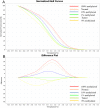Identification and validation of colorectal neoplasia-specific methylation biomarkers based on CTCF-binding sites
- PMID: 29371978
- PMCID: PMC5768395
- DOI: 10.18632/oncotarget.23172
Identification and validation of colorectal neoplasia-specific methylation biomarkers based on CTCF-binding sites
Abstract
To date, the sensitivity of currently available biomarkers based on the methylation of gene promoters is suboptimal for detecting adenomas and early-stage colorectal cancer (CRC). We aimed to develop biomarkers with methylated DNA binding sites of the multifunctional transcriptional factor CTCF for early detection of CRC. Using combined analyses of genome-wide occupation and the methylation profile of CTCF-binding sites, we identified candidate CTCF-binding sites. Then, we applied methylation-sensitive high-resolution melting (MS-HRM) and mass spectrometry analysis to screen and validate these candidate sites in diverse sample sets. We identified a set of colorectal neoplasia-specific biomarkers with robust performance. The top five biomarkers were selected and recommended for early detection of colorectal neoplasia. All of the five novel biomarkers exhibited a more robust discriminatory performance than that by BMP3 and NDRG4, two currently acknowledged robust methylation biomarkers. When the five new biomarkers were considered as a marker panel and tumor-positive was defined as having two or more (of the five) positive biomarkers, the marker panel could achieve a sensitivity of 91.67% for adenomas, 97.44% for Stage I CRC, 94.06% for Stage II CRC, 93.62% for Stage III CRC, and 93.54% for total colorectal tumors with a specificity of 94.05%. To our knowledge, this is the first study for colorectal neoplasia-specific methylation biomarkers based on CTCF-binding sites. Using a similar strategy, CTCF-binding sites could be potentially developed into biomarkers for other tumors. In summary, this study opens a new area in developing biomarkers for tumor prevention and treatment.
Keywords: CTCF-binding site; DNA methylation; biomarker; colorectal cancer; early-detection.
Conflict of interest statement
CONFLICTS OF INTEREST All authors disclose no potential conflicts of interest.
Figures


Similar articles
-
Promising Epigenetic Biomarkers for the Early Detection of Colorectal Cancer: A Systematic Review.Cancers (Basel). 2021 Oct 2;13(19):4965. doi: 10.3390/cancers13194965. Cancers (Basel). 2021. PMID: 34638449 Free PMC article. Review.
-
Stool DNA methylation assays in colorectal cancer screening.World J Gastroenterol. 2015 Sep 21;21(35):10057-61. doi: 10.3748/wjg.v21.i35.10057. World J Gastroenterol. 2015. PMID: 26401070 Free PMC article. Review.
-
Genome-wide identification and validation of a novel methylation biomarker, SDC2, for blood-based detection of colorectal cancer.J Mol Diagn. 2013 Jul;15(4):498-507. doi: 10.1016/j.jmoldx.2013.03.004. Epub 2013 Jun 7. J Mol Diagn. 2013. PMID: 23747112
-
DNA methylation of phosphatase and actin regulator 3 detects colorectal cancer in stool and complements FIT.Cancer Prev Res (Phila). 2012 Mar;5(3):464-72. doi: 10.1158/1940-6207.CAPR-11-0315. Epub 2011 Dec 1. Cancer Prev Res (Phila). 2012. PMID: 22135045
-
Novel methylation panel for the early detection of colorectal tumors in stool DNA.Clin Colorectal Cancer. 2010 Jul;9(3):168-76. doi: 10.3816/CCC.2010.n.023. Clin Colorectal Cancer. 2010. PMID: 20643622
Cited by
-
Promising Epigenetic Biomarkers for the Early Detection of Colorectal Cancer: A Systematic Review.Cancers (Basel). 2021 Oct 2;13(19):4965. doi: 10.3390/cancers13194965. Cancers (Basel). 2021. PMID: 34638449 Free PMC article. Review.
-
Prognostic and Predictive Epigenetic Biomarkers in Oncology.Mol Diagn Ther. 2019 Feb;23(1):83-95. doi: 10.1007/s40291-018-0371-7. Mol Diagn Ther. 2019. PMID: 30523565 Free PMC article. Review.
References
LinkOut - more resources
Full Text Sources
Other Literature Sources

